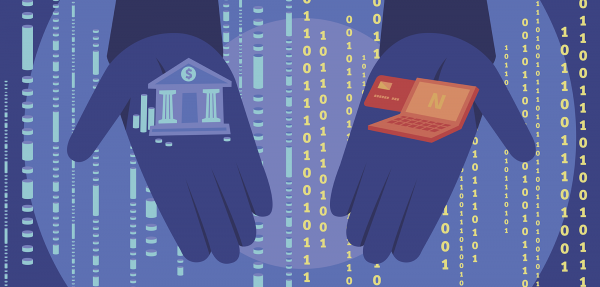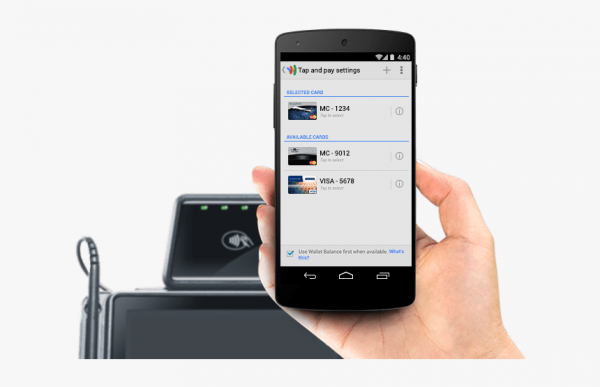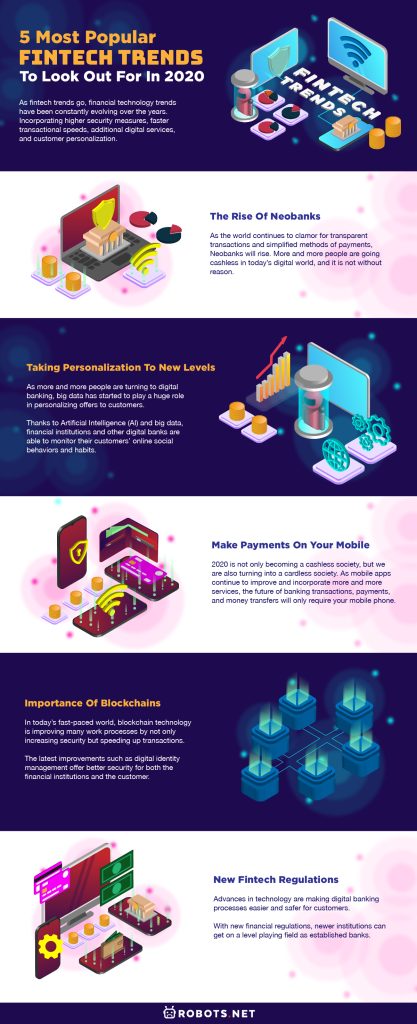Fintech is not something new. Since the inception of Bitcoin and cryptocurrency, financial technology has slowly, but steadily, come to the forefront of the digital banking and finance industry. As fintech trends go, financial technology trends have been constantly evolving over the years. Incorporating higher security measures, faster transactional speeds, additional digital services, and customer personalization, fintech trends are never stagnant. Did you know that according to a report by PwC, “global investments in fintech have more than tripled since 2014 to over $12 billion”? For an industry with such exponential growth, it’s no wonder that businesses are beginning to rely on fintech as they move into the new decade. Here are 5 of the biggest fintech trends to look out for in 2022 and beyond.
1. The Rise of Neobanks
Like Neo, from The Matrix movie series, digital banking has been the disruptor to Agent Smith’s traditional banking in recent years. These financial upstarts fall into two major categories, Challenger Banks and Neobanks. Challenger banks are predominantly established financial institutions that are trying to compete with powerhouses, while Neobanks are newer companies that are fully digital or work through mobile providers. These two new banking options are reshaping how the layman conducts daily business transactions. The foundation of digital banking was built on the idea of transparency. To compete with traditional institutions, Neobanks offer additional services such as cards, payments, investment opportunities, and stocks and shares trading. One of the biggest examples of a digital bank is Uber. From humble beginnings as a ride-hailing app, Uber quickly included Uber Eats, Uber for Business, Uber Freight, and even Uber Health. The power in Uber is not simply providing a “taxi” service, but the hassle-free payments to these multiple businesses through a single e-wallet on the app. As the world continues to clamor for transparent transactions and simplified methods of payments, Neobanks will rise. More and more people are going cashless in today’s digital world, and it is not without reason. Digital banks and financial services are enabling customers to conduct their business from the comfort of their own homes. Gone are the days where long queues at the bank or automated machines are required to pay bills or conduct business transactions. Today, you can do everything on your mobile phone while on the way to lunch.
2. Taking Personalization to New Levels
Walking into a bank and having the staff offer a formal salutation while asking if you want coffee or tea while you wait, is very satisfying. This personalized service is only offered when you turn up at these traditional financial institutions. However, in today’s digital age, a new type of personalization is growing steadily. As more and more people are turning to digital banking, big data has started to play a huge role in personalizing offers to customers. Thanks to Artificial Intelligence (AI) and big data, financial institutions and other digital banks are able to monitor their customers’ online social behaviors and habits. This data allows businesses to track and understand their customers’ likes, dislikes, and personal and business preferences. By gathering all this data, and with the help of AI to sieve through the information, banks can provide personalization to their services rendered. They can push customized advertisements for services that you will be interested in, instead of bombarding you with everything and losing your interest. With the advances in AI technology, the gathering of big data, and the ability to push targeted advertisements to specific individuals, digital banks are taking personalization to new levels.
3. Make payments on your mobile
According to Fintech Times, the “Internet of Payment” is reshaping the way customers are interacting with how money is changing hands. You can make purchases, pay bills, and transfer money on your mobile phones through mobile banking apps. This is not only faster and more efficient, but it gives customers a higher level of control and greater transactional transparency. At a time where it is trending to go cashless, mobile payment apps have taken it up a notch. Mobile payment apps are not only limited to financial institutions and banks but other digital platforms like Uber and China’s WeChat as well. These days, you don’t even have to carry a wallet around with a credit or debit card. You can use your mobile phone to complete almost all your daily transactions. You can pay for your taxi ride, buy the weekly groceries, and even split the dinner bill between your friends at the press of a button on your phone. 2022 is not only becoming a cashless society, but we are also turning into a cardless society. As mobile apps continue to improve and incorporate more and more services, the future of banking transactions, payments, and money transfers will only require your mobile phone.
4. Importance of blockchains
For the longest time, blockchains were synonymous with Bitcoins and cryptocurrency. But what exactly is a blockchain? Why is it so important to the fintech industry? A blockchain is a system that allows information to be shared, but not altered. This means that people can see the information and add new information, but never delete any information within the chain. This level of transactional transparency is vital for banking and financial institutions because everyone can see what is happening, but no one can change it. This hugely improves the security measures around these digital institutions. In today’s fast-paced world, blockchain technology is improving many work processes by not only increasing security but speeding up transactions. The latest improvements such as digital identity management offer better security for both the financial institutions and the customer. As more and more people switch to digital banking, blockchains can help alleviate financial audit concerns and reduce the chances of fraud. The saying, “Time is money” has never been more apt than in the banking and finance industry. Technology has allowed trading and buying stocks and shares to be done online and on your mobile phone. But the key is to do it quickly. Any lapse in timing can cost businesses and individuals a lot of money. Blockchains are helping to speed up this process by expediting investment actions, payment processes, and money transfers. Blockchain technology continues to evolve and grow every day. Therefore you can expect more businesses and financial institutions to adopt blockchains as part of their everyday work processes.
5. New Fintech Regulations
Advances in technology are making digital banking processes easier and safer for customers. But we need to remember that these financial institutions are still businesses. They are trying to win you over as a customer and earn your money. As per traditional banks, when it comes to money, there must be regulations to protect both parties. Banks need to operate with as much transparency as possible. Hopefully, this will reduce the cases of fraud and mismanagement within the financial industry. Similarly, regulations are in place so that customers do not find loopholes to cheat and hide money from the authorities. With new financial regulations, newer institutions can get on a level playing field as established banks. In the past, established institutions have warned customers against sharing information with digital banks. They tried to scare customers into believing that digital banks were not secure. Hackers could break in and steal personal information. This fear of sharing led to customers steering clear of digital institutions and depriving them of potential customers. It is because of these regulations that smaller businesses can now be on a level playing field.
Conclusion
Understanding fintech trends that are shaping 2022 is good, but what does it hope to achieve for the masses? At the end of the day, businesses and customers want a one-stop-shop to manage all their financial needs. Customers want to be able to make payments, transfer money, invest, and manage their finances through a single portal. Businesses are trying to achieve that by incorporating more and more services to their already substantial stable of procedures online. Many businesses and financial institutions have not completely switched to a digital system. Many smaller businesses do not even accept cashless transactions at the moment. However, the call for them to go cashless has been loud and frequent but the pick-up rate has been slow. This is not to say that fintech trends are insignificant. It is because the digital transformation learning curve is too steep at the moment. Given time and technological advancements, the majority of businesses could go cashless by the end of the decade. Understanding the biggest fintech trends and how it will shape the economy is crucial in taking the next step.



